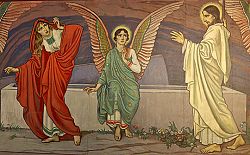Mary Magdalene: Patron Saint of the Diocese of Salt Lake City

Michael Courtney
Diocese of Salt Lake City Archivist
On Sept. 26, 1871, Archbishop Joseph S. Alemany of San Francisco came to the Utah Territory to dedicate the first Catholic Church in Utah. The red brick building, on the northwest corner of Second East and First South in Salt Lake City, was named St. Mary Magdalene Church.
How and why Father Patrick Walsh, the pastor who built the church, selected St. Mary Magdalene as patroness remains a mystery, because no records documenting the decision exist.
In some ways, the selection of St. Mary Magdalene as patroness of the first church in Utah and, later, the Diocese of Salt Lake City, makes sense. At the time she was very popular in Europe and, with large-scale European immigration to the United States in the 1800s, the cult of Mary Magdalene followed European immigrant groups to America. Gradually, the Mary Magdalene veneration became enmeshed in popular American culture.
To understand the evolution of Mary Magdalene from historical figure to a mythical one must look to early Christianity. In her marvelous book, The Making of the Magdalen: Preaching and Popular Devotion in the Later Middle Ages, historian Katherine Ludwig Jansen analyzes the homilies on Mary Magdalene by medieval clergy, and how people reacted to those homilies. Jansen starts her discussion on Mary Magdalene by examining her name, followed by a close look at the writings of the early Christians, the Patristic Fathers and the Early Medieval period.
Mary was a common name in Jewish culture. Mary Magdalene was set apart from other women of her time by her surname, which referred to the town she lived in, Magdala. Most ancient Israeli women’s surnames were linked to a man, normally a husband. The fact that Mary Magdalene’s surname was not connected to a man suggests she lived an independent life.
Jansen also surveys how the Gospel writers documented the person of Mary Magdalene. Scripture documents that she was healed by Jesus, loyally followed him during his ministry, stood beneath the cross at Christ’s crucifixion, took care of Christ’s’ body while it was in the tomb, was the first to see the risen Christ and also was the first of Jesus’ followers to proclaim his Resurrection.
In the Patristic and Early Medieval eras, three important changes occurred, Jansen notes. First was the creation of the liturgical calendar. Bede’s martyrology notes that Mary Magdalene’s feast day is July 22, meaning early Christians already venerated Mary Magdalene.
Second, many authors wrote hagiographies about Mary Magdalene, portraying her either as a repentant sinner who chose to live in the desert for 30 years or a person who preached and performed miracles.
The final development was the amalgamating of Biblical Marys. In 591, Pope Gregory the Great combined the Marys mentioned in Luke 7:37-50, John 11:45;12:1-8 and Mark 16:9 into one person: Mary Magdalene. Other writers made similar mistakes; for example, Hippolytus viewed Mary Magdalene and Mary of Bethany as the same person.
These three events “ordained the agenda of Magdalene veneration for the entire Middle Ages and well beyond,” Jansen concludes.
Rooted in the historical milieu, medieval clergy through their preaching constructed images of Mary Magdalene that made their way into the popular culture of 20th-century Utah. According to Jansen, medieval clergy referred to Mary Magdalene as the Apostle of the Apostles because she remained loyal to Jesus when other disciples failed him. One of the most popular versions of the Resurrection story retold in Utah newspapers during Easter was from the Gospel of Matthew. Matthew relates that Mary Magdalene and the other Mary visited Jesus’ tomb. When they arrived at the tomb, an angel told them that Jesus had risen and told them to go tell others this news. They did. In some iterations of the Resurrection story, recalled in the newspapers, Jesus appears only to Mary Magdalene and Mary, while in others Jesus appeared to all the disciples.
Another vision of Mary Magdalene created by clergy in the Middle Ages is the repentant sinner. Reforms of the Sacrament of Penance in that era made private confessions the norm, rather than vigils, pilgrimages and fasting. Mary Magdalene became a symbol of penitential reform: “If one followed the way of penance, illuminated by the example of Mary Magdalene, one could, like the saint, find a glorious end in heaven,” Jansen writes. The theme of Mary Magdalene as repentant sinner found its way into many 20th-century works, such as Maurice Macterlinck’s 1909 play and Cecil B. DeMille’s movie “The King of Kings.”
The perception of Mary Magdalene has shifted through the centuries, from the early Church through the Middle Ages and into the present. The Cathedral of the Madeleine, named in her honor, has also one significant change. It originally was named the Cathedral of St. Mary Magdalene. However, after extensive renovations of the interior in the early 1900s, the Most Rev. Joseph S. Glass, C.M., second Bishop of Salt Lake, decided to change the name to Cathedral of the Madeleine, the French version of Magdalene.
As patron saint of the Diocese of Salt Lake City, Mary Magdalene continues to offer hope and inspiration, whether we view her as a repentant sinner or as the Apostle to the Apostles, or both. On July 22, her feast day, we can join the diocese in honoring her in prayer, whether in private or at Mass in the Cathedral of the Madeleine.
© Copyright 2025 The Diocese of Salt Lake City. All rights reserved.

Stay Connected With Us